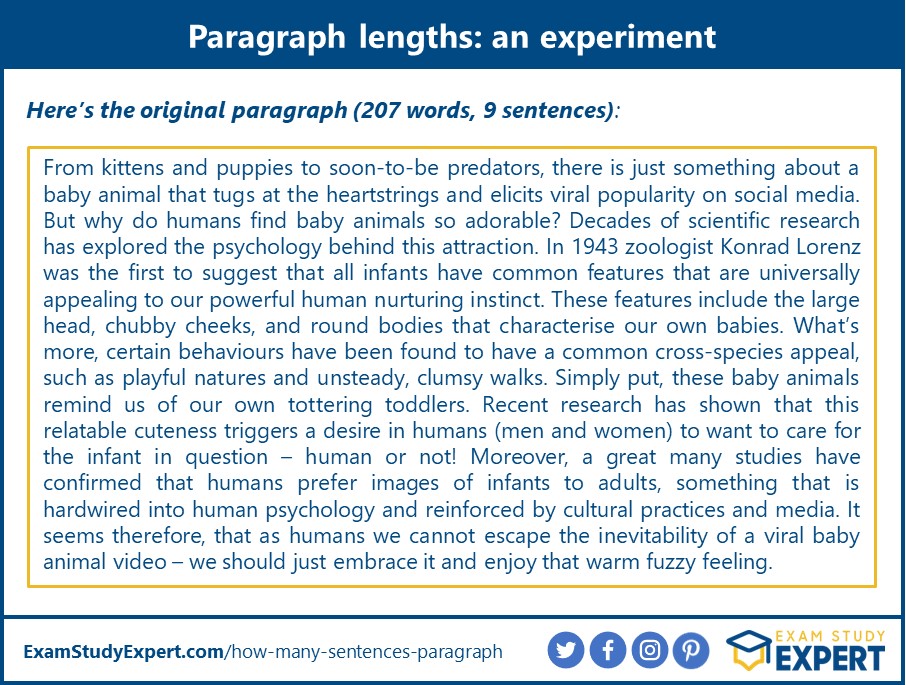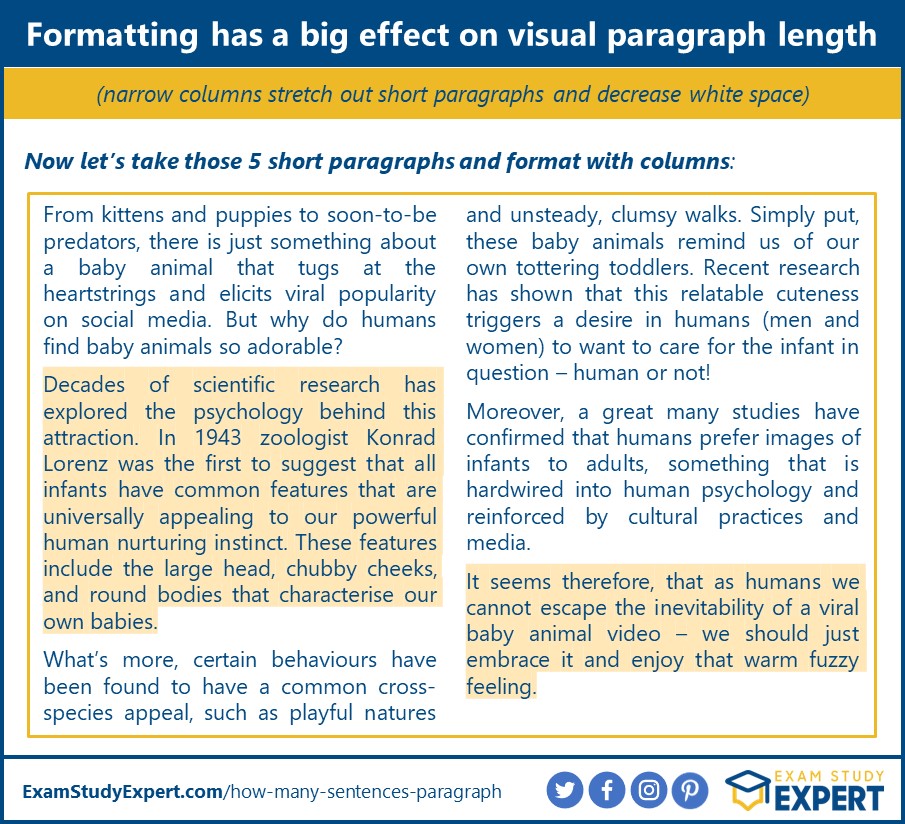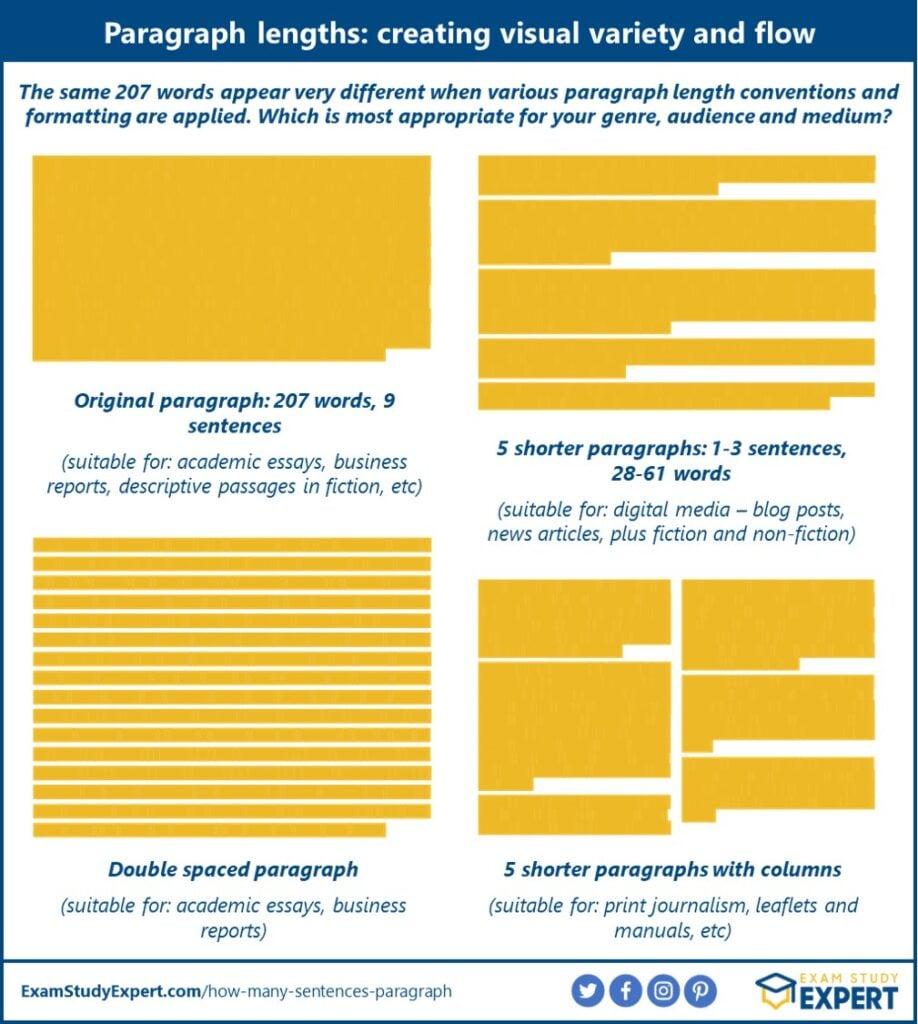Conventional wisdom says that a well-developed paragraph should ideally be 100-200 words long, and 5-6 sentences maximum. But … well, that’s not really true. In fact, the best answer to “how many sentences are in a paragraph” is it depends …
Why? Well, the ideal paragraph length varies wildly depending on what you’re writing: academic papers, news articles, blog posts, a novel, a business report … Plus, an effective, well-written paragraph should really be measured in ideas, not sentences.
That’s the short answer. So what’s a writer to do?
Why, keep reading! We’re diving in to paragraphs for every occasion (and running a little experiment in creating visual variety and flow). To get you started, here’s a handy summary on how many sentences (and words) should be in a paragraph, by genre:

Is it always that simple? Of course not!
But if you want to learn more about why these recommendations are the case, how much flexibility you have, and when you can break the guidelines: read on, we’ve done the research and we’ve got the low-down …
Behind the scenes:
Our mission is to provide reliable and accurate content to help students reach their academic goals. To ensure our articles meet a high standard, we follow a rigorous editorial process from research to review. To learn more, please see our Editorial Policy.
By Dr Kerri-Anne Edinburgh, our Cambridge University educated specialist in study skills, mindset, research and writing. As Head Writer and Editor for the popular Exam Study Expert blog since 2021, Kerri has spent over three years immersed in the psychology of learning, ensuring each article is packed with valuable insights, practical tips and helpful graphics.
Article review by William Wadsworth
Paragraphs: a brief overview
Let’s start off with a quick overview on the wonderful world of paragraphs:
If you’re confident in your paragraph knowledge (or you’ve already read our excellent guide on what is a paragraph), feel free to skip ahead!
- A paragraph is a collection of sentences that are grouped to explain a single idea
- It should fully contain and develop that one idea
- Ideally, your paragraphs should be as long or as short as they need to be to discuss each individual idea
- Paragraphs offer important visual markers and invisible punctuation for your readers by dividing your content into readable chunks
- Paragraphs help you to improve the flow of your writing and guide your readers with signposting and transitions
- Shorter paragraphs improve readability by increasing white space (which is especially important for digital media accessed on small screens!)
Essentially, your paragraphs should work alongside your sentences to create maximum readability and accessibility for your readers. Lean more about the science of reading and literacy over in our paragraphs 101 article!

When should you start a new paragraph?
Unfortunately, the answer isn’t as simple as “when your current paragraph gets too long”! Instead, it’s all about effectively dividing up your ideas and points.
In order to guide your reader effectively, accepted wisdom states that you should start a new paragraph for every change in topic, perspective, speaker, or time. So make sure you create a break before every new section, piece of evidence, counter-argument, different viewpoint, step in a sequence, tangent, new character, or conclusion!
If you’re not sure how to start all these new paragraphs you’re forming, we’ve got you covered: our article on how to start a paragraph is full of vocab and helpful phrases to get you started!
Top tip: The best way to handle your paragraphing effectively is to wait until after you’ve written your first draft (when you’ve worked and collected your thoughts and ideas). Then, with the help of an outline, you can avoid waffle and divide up your work effectively along the seams between each new point! And hey presto: Goldilocks paragraphs that are never too long or too short, but just right for this specific idea!
(N.B. If your paragraphs are looking a little lengthy, your paragraphs breaks may not be the only culprit! If you’re an incurably waffly writer take a look at your sentence lengths too.)
When are shorter paragraphs better?
Before you get started, you should always be sure of 5 things: the type of writing you’re doing, it’s purpose, audience, and final format and medium. Because these 5 factors have a significant impact on the ideal lengths of your paragraphs.
(In fact, the next section is a great demonstration of this impact: we’re going to do an experiment in paragraph lengths and visual effect!)
When we read, our eyes don’t focus on every word. Instead, they move in leaps called “saccades”. Research is now exploring the relationship between eye movement and cognitive processing when reading.
Breaking up text with smaller paragraphs helps to guide your eyes as they leap and scan. This increases readability and accessibility.
That makes the format and medium of your work especially important for determining the length of your paragraphs!
Unless you know your work will be read in print, you audience will probably be online – and on their mobiles! And that means small screen sizes. As with traditional multi-columned print media, small screens stretch short paragraphs to fill a far greater space. Suddenly all that white space you’d created for visual flow has disappeared again.
So know your five factors – they’re a crucial part of the recommendations below!
Paragraphs: the takeaway
Now you know what a paragraph should do and where to divide yours, here’s our most important recommendation:
For the most effective paragraphs – those that guide your reader well and keep them captivated – your paragraph lengths should be measured by ideas. Not (just) by number of sentences or words, or even by physical length on the page.
Imposing artificial constraints on your paragraph lengths can make your writing feel unnatural and twist the purpose of your paragraphs.
However …
Writing conventions exist for a reason and knowing the recommended lengths for your genre of writing can be very helpful for avoiding an embarrassing faux pas and creating ideal readability.
What do different lengths of paragraphs really look like?
Before we get into genre-specific recommendations, let’s do an experiment in the art of measuring how long your paragraphs should be 😊
First up, how are you measuring your paragraph lengths? By sentences? Word count? Length on the page? Each of these methods has its pros and cons.
- Sentence length is dependent on how wordy your sentences are. You can pack far more short sentences in 200 words than you might think!
- Constraining your word count too much can push you into weird grammatical decisions or stop you from fully developing your paragraph. But it can also force waffly writers to be concise!
- Length on the page is fully dependent on your final formatting (we need that white space!).
The big question is: Do you actually know what “5-6 sentences” or “200-300 words” of your writing actually looks like?
(I have to say, before writing this article, I’m not sure I did. I checked out the word length of paragraphs from a variety of writing, including my PhD thesis, articles I’ve referenced here, and this article … and it was quite illuminating!)
An experiment in paragraph lengths
For our experiment, I’ve picked a topic (cute baby animals), and written a paragraph adapted from BBC Earth’s article “Code for Cuteness”. It’s 207 words and 9(!) sentences long. Those sentences vary from 9-29 words in length.
Let’s explore how those 207 words look in different contexts:

That’s a pretty hefty chunk of text, and looks fairly out of place in this article! Yet, a solid 200-word paragraph like this would be more than appropriate in an academic work, or a report or informative paper. Even within creative writing longer descriptive paragraphs can be a great tool for guiding the reader through your world.
Breaking down longer paragraphs
So how might you approach this text for more informal contexts – like this blog, or the original article? For a digital context, dividing it up at each new point (topic, original research, behavior, triggers, conclusion) into short paragraphs creates a much visually easier read:

I’ve highlighted the longest (3 sentences) and shortest (single-sentence) paragraphs. Sure, they’re short, but for the right audience (the general internet public) these paragraphs are far more approprite and increase readability and accessibility. In fact, this division fairly accurately reflects the original article.
Another big consideration is the final medium of your writing: print media and other documents often use a multi-columned format that stretch even 28-word, one-sentence paragraphs onto several lines:

Changing the formatting has completely altered the way we perceive the lengths of these paragraphs, and it’s exactly the same division as the example above! You can see why shorter paragraphs (and sentences) are a prominent feature of some printed media (think news articles).
A visual comparison
Let’s round off this experiment with one last example: a visual comparison of these paragraphs side by side. I’ve added an extra double-spaced version to demonstrate how much of a (imagined A4) page 200 words can quickly consume – roughly half!

There’s a significant difference in the visual guide and variety offered to our imagined readers here. And that’s a great reminder of why your audience, format, medium are such important considerations when making paragraphing decisions for maximum readability and engagement.
Having explored these examples, have you got a better idea of what the recommendations below really mean and look like in practice? I hope so!
How many sentences (and words) should be in your paragraphs – by genre
Here we are: the accumulated wisdom of paragraph length advice you’ve been waiting for.
And whilst I definitely do not recommend shoehorning all your paragraphs into a formulaic length, there are many times when the conventions of your genre are useful. Especially when it comes to recommendations for maximum paragraph length to create ideal readability for your audience and medium.
Tip: if you’re ever unsure what you can get away with, grab a copy of a similar document and do a quick comparison with their paragraph lengths!
Academic writing
As your academic career develop, so too should the complexity of your paragraphs as you write longer papers and dissertations! So let’s consider two stages of academic paragraphing:
Paragraphs in school
The traditional paragraph formula learnt in school teaches you to craft effective, focused arguments. For younger students, it’s an efficient way to present ideas and evidence in basic persuasive writing. It goes like this:
- Start with a topic sentence that sets out your main idea.
- Give 1-2 sentences of supporting evidence for (or against) your argument
- Next, write a sentence analysing this evidence with respect to your argument or topic sentence
- Finally, conclude your paragraph and provide a transition to the next paragraph
And bingo: the perfect recipe for that 100-200 word paragraph composed of 5-6 sentences!
However, this model won’t always help you create effective paragraphs, or easily-readable longer essays!
Instead, make sure you focus on conveying your ideas concisely, fully exploring one idea in your paragraph, and using paragraph breaks and transitions to the best effect.
Paragraph length recommendation: a traditional 5-sentence model, with 100-200 words per paragraph can work well for school essays.
Higher academia: Dissertations, theses and papers
Once you reach university and higher academia, you’ll be creating far more complex documents – from college essays, to 10,000 word dissertations and papers, to 100,000 word PhD theses!
Most academic papers contain a variety of paragraph lengths as appropriate for their context. At this level of writing short paragraphs are rare, as fully developing your argument within each paragraph takes time. Digression is frowned upon, so make sure you create a new paragraph for each new topic, counter-argument and tangent.
Traditional paragraph models can still be found, especially when writing transitional paragraphs that provide summaries and signposting for the remainder of the paper. Additionally, signposting and well-placed headings become equally important features for guiding the reader through the argument.
There’s plenty of advice about academic paragraph length available online. Suggested paragraph lengths vary from 100-200 words, 150 words, to 250 words in 5-6 sentences.
A big consideration for paragraph length will be the final formatting. Paragraphs in a double spaced A4-sized PhD thesis will look vastly different to a two-columned academic journal. (In my own PhD thesis, 300-word paragraphs lasted two thirds of a page – that’s quite a chunk of text for the reader!)
Paragraph length recommendation: short paragraphs are rare as sentence complexity is higher, and you should avoid single-sentence paragraphs! As a general guideline, a paragraph should be 2-3 sentences minimum, and 5-6 sentences maximum, and not longer than 300 words.
Journalistic writing in print media
Paragraphing is an important tool for journalistic writing because it provides a recognisable visual outline for the reader.
Paragraph style forms an essential part of the appearance of print media, and formatting is a significant consideration with many types of multi-columned print mediums (newspaper, magazine, leaflet or brochure).
Journalistic paragraphs are usually short, especially when compared to literary or academic paragraphs. Narrow margins, stretched columns, and lighter discussions make this an obvious choice. There is, however, conflicting advice on length:
Some sources suggest that the average paragraph length is about 75 words (approx. 3-4 short sentences of less than 25 words). Others recommend a shorter goal, of 50-70 words (2-3 sentences). For single-columned writing, there’s space for slightly longer paragraphs (4-5 sentences). And single-sentence paragraphs are acceptable – and impactful!
Nevertheless, the same principles apply for paragraph breaks: ideally, each paragraph should be self-sufficient and handle one topic. Careful outlining is a key skill for this genre of writing.
Paragraph length recommendation: aim for less than 75 words (that’s about 3-4 sentences, 25 words per sentence maximum for ideal readability for the general public).
Writing for digital media: blog posts and articles
Paragraphing is a matter of tone, and when you move into online content, the rules of writing become far more informal.
Short paragraphs are, once again, the name of the game. Why? There are several important reasons: audience, limited online attention-spans, and formatting for readability on small screens.
The key goal is keeping readers engaged with your content. Digital media consumers want instant gratification, so it pays to make your information clear and obvious, break down large chunks of text, and make it easy for readers to scan the information.
- Fun fact: This process of breaking down text into manageable, memorable chunks for your audience is known as chunking (from the cognitive psychology term and popular study method!).
In fact, one way to consider sections of online content is as deconstructed paragraphs – the full expression of the idea is there, but those 200 words are split into 5 paragraphs instead of one, contained within a subheading (as shown in the experiment above!).
What are you writing?
However, style guides suggest that the ideal length depends on the type of content you’re writing:
- Blogs aim to create a welcoming, friendly voice for their readers, and writing is more conversational. One-sentence paragraphs are perfect for this, and 2-sentence paragraphs can fill small screens easily. Coschedule recommend a maximum of 3 sentences and 75 words per paragraph for blog posts.
- Frequent headings and subheadings, itemised lists and infographis are frequently used tools to provide visual variety and break up paragraphs.
- Media releases and news articles usually have 1-2 sentences per paragraph, and often less than 50 words. Given that total article lengths may be limited to 300-500 words, that’s not surprising!
- Informative guides and official corporate media also prioritise accessibility (as we’ve seen above), and guidelines suggest 2-3 sentences in plain language with a maximum of 25 words per sentence.
- Digital reports and long-form content has more room for longer paragraphs – up to 6 sentences in a paragraph is acceptable (approx. 100-150 words).
Looking for an interesting read on the literary implications of shrinking paragraphs in digital media? Try this fascinating analysis.
Paragraph length recommendation: make the most of having a variety of paragraph lengths for visual impact, from single-sentence paragraphs to those with 2-3 sentences (50-75 words). If you’re writing a longer article or report, longer paragraphs may be more appropriate, with 100-150 words.

Business writing: reports and white papers
There are notably fewer guides available for understanding paragraph length conventions in business writing than academic writing. Nevertheless, there are some guidelines you can follow.
Style guides suggest that paragraphs with 3-6 sentences are an ideal length. Those longer than 100-125 words should be rare. Single-spaced paragraphs should not exceed one-third of a page, and for double-spaced paragraphs half a page.
The final formatting and appearance of your writing should be an important consideration for paragraph lengths:
- Multi-columned layouts are popular within reports, brochures, leaflets, instruction booklets and manuals. The narrow columns require shorter paragraphs of roughly 50 words.
- If you’re writing a larger document with a full-page layout, such as a lengthy report or white paper, longer paragraphs are acceptable (100-125 words, and 5-6 sentences maximum).
You should also examine any existing reports and style guides available in your company/for your specific field, as expectations may vary in different professional settings!
N.B. Even in technical documents, the recommended sentence length is fewer than 25 words, using plain language where possible.
Paragraph length recommendation: depending on your final formatting, aim for paragraphs around 50 words (2-3 sentences) for narrow columns, or up to 125 words (5-6 sentences) for full-page layouts.
Creative writing: fiction and non-fiction
Within the realm of creative writing, there is far more room to find your own style: the guidelines are fairly fluid and you have a lot of creative licence. Paragraphs give your narrative a flow and rhythm for the reader to ride.
(Having said that, there are still some conventions that should be followed, such as paragraph breaks for a change of speaker during dialogue, or to indicate a change of perspective, time or scene.)
Fiction
If you’re writing fiction, paragraph length conventions vary wildly by genre. A reader is usually more likely to find lengthy descriptive paragraphs in fantasy novels than in light romances.
Single-sentence paragraphs are acceptable, with great dramatic impact for a narrative. Detailed descriptive and scene-setting paragraphs are more likely to be long, with at least 100-300 words.
Variety is important (although shouldn’t be forced). Too many short paragraphs can be distracting and make your writing feel choppy. Take note of the mood and tone, and let your paragraphs feel natural for your story-telling.
And remember your audience – the expected age of your readers should play an important role in the readability of your writing. For example, fiction for young children has a completely different set of expectations, from overall length to style!
- Tip: If you’re struggling with your paragraph lengths, a great activity is to grab a selection of books that inspire you and examine them! Explore different paragraph lengths by flipping to random pages (try to get a mixture of dialogue, action and description) and considering the number of paragraphs to the page and sentences per paragraph! Get started by popping down to the “fun stats” section below.
Non-fiction
Large-scale non-fiction writing (i.e. biographies, histories etc) may more closely resemble the persuasive writing of academia or informative style of reports than fiction – however, you’re still creating a narrative, not an essay!
So don’t be too constricted by 100-200 word guidelines. Instead, embrace a variety of 1+ sentence paragraphs for effective story-telling.
Paragraph length recommendation: paragraph lengths in fiction vary wildly: explore some of your favourite books for genre-specific inspiration. If you’re writing non-fiction, variety in paragraph can create impact (i.e. 1+ sentences)
Fun stats about paragraphs in famous fiction
To finish up, and for a little light relief (because it’s interesting!), here’s a brief look at the variety of paragraph lengths found in the works of famous authors across the ages.
If you’re an aspiring novelist yourself, then this might be a helpful section for you 😊
I’ve collected the paragraph lengths found in some well-known stories, with thanks to some really interesting analyses by Jefferson Smith and Edwin Lewis’s The History of the English Paragraph (1894).
- Daniel Defoe, Robinson Crusoe (1719)
- Average words per paragraph: 141.63
- Average sentences per paragraph: 1.8
- Jonathan Swift, Gulliver’s Travels (1726)
- Average words per paragraph: 234.74
- Average sentences per paragraph: 5.85
- Charles Dickens, The Old Curiosity Shop (1840-41)
- Average words per paragraph: 50.67
- Average sentences per paragraph: 2.13
- J.R.R. Tolkien, The Lord of the Rings (1954)
- Longest paragraph: 483 words
- 95% of paragraphs less than: 142 words
- William Goldman, The Princess Bride (1973)
- Longest paragraph: 435 words
- 95% of paragraphs less than: 102 words
- Stephen King, The Dark Tower (2004)
- Longest paragraph: 286 words
- 95% of paragraphs less than: 95 words
If you’re interested in exploring more literary eccentricities and debates, here’s some articles on exceptionally long opening sentences, Dickens’s rule-breaking and literary paragraph conventions.
How long is a paragraph? The summary
The true ideal length of your paragraphs should be: as long or as short as needed to contain and discuss one single idea.
However, the paragraph length conventions of your writing genre are an important tool. They act as a guide for learning the maximum and minimum accepted length for ideal readability for your specific audience and final medium.
Remember that the rules for formal documents are often stricter than informal, more creative ones!
Here’s a recap of our recommendations based on the guidelines we researched:

- School essay: you can stick to a traditional 5-sentence model to build well-developed ideas – just don’t be too repetitive!
- Academic paper or thesis: avoid single-sentence paragraphs, and fully develop your ideas with a variety of lengths (approx. 2-6 sentences, 100-300 words)
- Print journalism: short and sweet is key, ideally less than 75 words (3 sentences)
- Blog posts: keep it short (1-3 sentences, up to75 words) to increase readability and aim for lots of variety
- Other digital content: break up paragraphs with lists and graphics, 2-3 sentences is plenty for small screens. For longer content, 100-150 words (up to 6 sentences) is acceptable
- Business and technical writing: 50 words (2-3 sentences) is plenty for multiple columns, and up to 125 words (5-6 sentences) for full-width pages
- Fiction and non-fiction: make the most of your creative licence, with 1-6 sentence paragraphs (up to approx. 300 words)!
Thanks for reading, a good luck with your next writing endeavour!
Ready to get writing, but not sure how to start? Pop over to our excellent guides on how to start an essay and how to start a paragraph for lots of advice and helpful vocab!

By Dr Kerri-Anne Edinburgh, our Cambridge University educated specialist in study skills, mindset, research and writing. As Head Writer and Editor for the popular Exam Study Expert blog since 2021, Kerri has spent over three years immersed in the psychology of learning, ensuring each article is packed with valuable insights, practical tips and helpful graphics.
Author Profile | About Us | Editorial Policy | Contact Us


